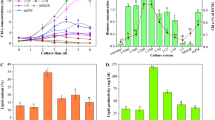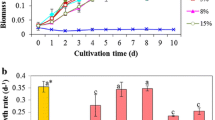Abstract
Sterile Ulva, which is a macroalga, has the potential to grow stably; therefore, this seaweed is expected to be an efficient resource of functional food containing various nutrients such as sulfur amino acids, proteins, carbohydrates, and minerals. Ulva lactuca was selected from the “Marine Park” in Tokyo Bay, and its growth rate (g-dry/[m2·d]) was measured using model reactors located on the land or on the surface of the sea at Yokohama. The growth rate of U. lactuca was recorded to be approx 20 g-dry/(m2·d), which is estimated to be 10 times greater than that in a natural field in the Marine Park. In addition, this growth rate was higher than that of conventional crops such as corn and rice on a farm or paddy. These data led us to newly design and propose a floating type of labor-efficient U. lactuca production system. d-Cysteinolic acid, which is included in U. lactuca as a major sulfur amino acid, inhibited the Fenton reaction, resulting in suppression of hydroxyl radical production and singlet oxygen. Addition of the sulfur amino acid (1µM) to HepG2 cells markedly decreased the intracellular triglyceride level. Hence, this proposed facility also has the potential for industrial production of a valuable resource for the primary prevention of lifestyle-related diseases using enriched or eutrophied seawater.
Similar content being viewed by others
References
Satake, M., Chiba, Y., Makuta, M., Fujita, T., Kohama, Y., and Mimura, T. (1987), Yakugaku Zasshi 107, 917–919 (in Japanese).
Satake, M., Mikajiri, A., Makuta, M., Fujita, T., Murakami, M., Yamaguchi, K., and Konosu, S. (1988), Comp. Biochem. Physiol. 90B, 151–153.
Ito, K. (1963), Bull. Jap. Soc. Sci. Fish. 29, 771–775.
Migita, S. (1985), Bull. Fac. Fish. Nagasaki Univ. 57, 33–37 (in Japanese).
Ohno, M. (1988), Marine Foul. 7, 13–17.
Hirata, H. and Kohirata, E. (1993), Isra. J. Aquacul Bamidgeh 45, 164–168.
Hirata, H., Yamasaki, S., Maenosono, H., Nakazono, T., Yamauchi, T., and Matsuda, M. (1994), Suisanzoshoku 42, 377–381.
Brind, X. and Morand, P. (1997), J. Appl. Phycol. 9, 511–524.
Goto, T., Une, M., Kihira, K., Kuramoto, T., and Hoshita, T. (1993), Biol. Pharm. Bull. 16, 1216–1219.
Une, M., Goto, T., Kihira, K., Kuramoto, T., Hagiwara, K., Nakajima, T., and Hoshita, T. (1991), J. Lipid Res. 32, 1619–1623.
Yanagita, T., Hara, E., Yotsumoto, H., Rahaman, S. H., Han, S. Y., Cha, J. Y., and Yamamoto, K. (1999), Curr. Ther. Res. 60, 423–434.
Hirayama, S., Ueda, R., and Sugata, K. (1994), in Magnetic Resonance in Medicine, Ohya, H. N., ed., Nihon-Igakukan, Tokyo, pp. 117–119.
Fujitani, Y., Kasai, K., Ohtani, S., Nishimura, K., Yamada, M., and Utsumi, K. (1997), J. Anim. Sci. 75, 483–489.
Devamanoharan, P. S., Ali, A. H., and Varma, S. D. (1997), Mol. Cell. Biochem. 177, 245–250.
Pokhrel, P. K. and Lau-Cam, C. A. (2000), Adv. Exp. Med. Biol. 483, 411–429.
Pokhrel, P. K. and Lau-Cam, C. A. (2000), Adv. Exp. Med. Biol. 483, 503–522.
Messina, S. A. and Dawson, R. Jr. (2000), Adv. Exp. Med. Biol. 483, 355–367.
Tanaka, K. and Sugano, M. (1989), J. Nutrit. Sci. Vitam. 35, 323–332.
Liu, L. and Yeh, Y. Y. (2001), Lipids 36, 395–400.
Hirayama, S., Ookubo, S., and Miyasaka, M. (1999), in Proceedings of the International OTEC/DOWA Association ’99, Uehara, H., Wang, J. H., and Ikegami, Y., eds., International Otec/Dowa Association and Saga University, Saga, pp. 273–279.
Murata, Y. (1975), Crop Productivity and Solar Energy Utilization in Various Climates in Japan, University of Tokyo Press, Tokyo.
Author information
Authors and Affiliations
Corresponding author
Rights and permissions
About this article
Cite this article
Hirayama, S., Miyasaka, M., Amano, H. et al. Functional sulfur amino acid production and seawater remediation system by sterile Ulva sp. (chlorophyta). Appl Biochem Biotechnol 112, 101–110 (2004). https://doi.org/10.1385/ABAB:112:2:101
Received:
Revised:
Accepted:
Issue Date:
DOI: https://doi.org/10.1385/ABAB:112:2:101




